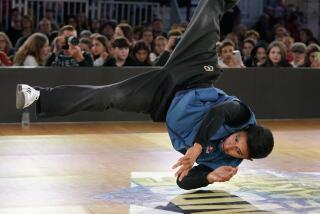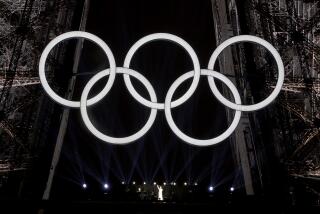Best Not in Show
- Share via
News item: Terje Haakonsen will not be present during the Winter Olympics at Turin, Italy.
Reaction: Terje who?
To some it seems like ages ago when the world’s greatest snowboarder said those nasty things about those who run the world’s greatest sports festival. Specifically, he compared then-International Olympic Committee President Juan Antonio Samaranch to mobster Al Capone and referred to IOC members as “ski-Nazis.”
“I guess I said that, but I was just trying to compare it to something,” the soft-spoken Haakonsen said of his comments before the 1998 Games at Nagano, Japan. “I was younger then, so I just, you know, was saying what I felt.”
To others, it seems like yesterday when snowboarding was to be included in the Winter Olympics for the first time; when the IOC decided to make the International Skiing Federation, or FIS, the sanctioning body, instead of the budding International Snowboarding Federation; and when it gave the athletes no say over how things would be run.
Haakonsen, then 23 and the dominant force in virtually all aspects of the sport, decided that FIS was full of itself and announced that he would not participate at Nagano.
A skiing organization running snowboarding, he maintained, “is like a wrestling association organizing a boxing match.”
It was a bombshell perhaps lost on today’s younger generation of snowboarders, many of whom are aware of the athlete and his unparalleled on-slope accomplishments, but not of the magnitude of his decision.
To the “Terje generation,” it’s a different story. A Winter Olympics cannot be held without Haakonsen becoming a topic of conversation. Of his many contributions, including the creation of the popular Arctic Challenge, the choice he made on the eve of the Nagano Games ranks as one of the most unforgettable.
“Terje snubbed [the Olympics] because he thought it was his responsibility,” said Circe Wallace, a former pro turned agent to many top action-sports athletes. “He didn’t participate because he knew it was not right, and he was willing to forgo his own interests in the best interest of snowboarding.”
Haakonsen couldn’t have known it at the time, but thumbing his nose at the IOC probably made him better-known than he would otherwise have become, for it made him a martyr as well as a legend.
“Terje embodies everything important about snowboarding,” Wallace said. “He has style that cannot be matched. It is distinct. He really has that kind of thing that champions have, that presence you can’t explain, but he exudes greatness without having to say a word.”
*
Haakonsen was born in 1974 and raised in a village in the Telemark region of Norway. Everybody skied, and Haakonsen was no exception. He recalls turning 360s on jumps he and his brother built in their backyard.
Snowboarding took root in 1986. Haakonsen tried the single plank in 1987 and became obsessed with the sport. Three years later he was signed as a team rider by Burton Snowboards and began competing among the elite and with the likes of superstars Craig Kelly and Jeff Brushie.
Haakonsen revered Kelly and emulated his style. Soon he was blowing minds on the competition circuit, whether in the halfpipe, big-air contests or banked slalom races.
In 1992 he defeated the seemingly unbeatable Shaun Palmer to claim his first of three U.S. Open halfpipe titles. In 1998 at the Mt. Baker Legendary Banked Slalom, out of boredom, he dropped into the course backward and finished fourth in a qualifier. He went on to win the event, something he has accomplished six times.
Snowboarding was experiencing growing pains, trying to emerge from its outlaw past. But it was becoming increasingly popular and caught the eye of the IOC. It was decided that snowboarding would make its Olympic debut in Nagano. FIS would dictate. Athletes would wear the uniforms given to them and sell the products on the uniforms.
“They also had given snowboarding the animal from the Muppets [as a mascot],” Wallace recalled. “It was a kick in the teeth. We were being represented by this crazy animal that grunted and dragged his knuckles.”
Nonetheless, the lure was too great for athletes eager to make a name for themselves. Ross Powers, who won the bronze at Nagano, said the Olympics helped launch his career.
Haakonsen, though, was already a millionaire, and Burton -- perhaps smartly, given the notoriety it would receive -- backed its top athlete’s decision.
When the Olympics began, Haakonsen was surfing in California. Ross Rebagliati became the first snowboarder to win an Olympic gold medal.
But he was still considered second-best by those within the industry.
Four years later at the Salt Lake City Olympics, U.S. riders Powers, Danny Kass and Jared “J.J.” Thomas made history by winning gold, silver and bronze medals, sparking a snowboarding renaissance throughout the country.
But again came the question: Would this sweep have happened had Terje been there?
That won’t be an issue this time around, as elite-level competition has become a younger man’s game.
Looking back at what might have been, Haakonsen said he has no regrets.
“It’s still FIS in charge,” he said, “and snowboarding isn’t about gold medals.”
That certainly appears true in the case of an athlete who has been doing most of his riding lately on the big mountains of the back country, inspiring there as he once did in the halfpipe and on the race courses.
So in a way the question remains: Will the Turin Games produce the world’s best snowboarders?
That depends on one’s viewpoint -- and perhaps one’s age. Wrote Kurt Hoy in Transworld snowboarding: “Terje tops my list because his style stems from supreme board control and technical ability, but it’s also fluid, spontaneous and powerful.
“A lot of snowboarders with good technical riding skills never evolve to have style, and a lot of riders with style are limited by their lack of ability. Terje’s well-roundedness is the key to his style -- I don’t think any other rider has ever had the same combination of skills, to the same degree that Terje has.
“I’ve never really tried to copy anyone’s style. I’ve always just wanted to refine my own, but if I could magically ride like someone else, I’d want to ride like Terje.”
More to Read
Go beyond the scoreboard
Get the latest on L.A.'s teams in the daily Sports Report newsletter.
You may occasionally receive promotional content from the Los Angeles Times.






